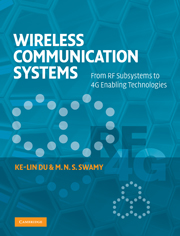Book contents
- Frontmatter
- Contents
- Preface
- Abbreviations
- 1 Introduction
- 2 An overview of wireless communications
- 3 Channel and propagation
- 4 Cellular and multiple-user systems
- 5 Diversity
- 6 Channel estimation and equalization
- 7 Modulation and detection
- 8 Spread spectrum communications
- 9 Orthogonal frequency division multiplexing
- 10 Antennas
- 11 RF and microwave subsystems
- 12 A/D and D/A conversions
- 13 Signals and signal processing
- 14 Fundamentals of information theory
- 15 Channel coding
- 16 Source coding I: speech and audio coding
- 17 Source coding II: image and video coding
- 18 Multiple antennas: smart antenna systems
- 19 Multiple antennas: MIMO systems
- 20 Ultra wideband communications
- 21 Cognitive radios
- 22 Wireless ad hoc and sensor networks
- Appendix A The Q-function
- Appendix B Wirtinger calculus
- Index
9 - Orthogonal frequency division multiplexing
Published online by Cambridge University Press: 05 June 2012
- Frontmatter
- Contents
- Preface
- Abbreviations
- 1 Introduction
- 2 An overview of wireless communications
- 3 Channel and propagation
- 4 Cellular and multiple-user systems
- 5 Diversity
- 6 Channel estimation and equalization
- 7 Modulation and detection
- 8 Spread spectrum communications
- 9 Orthogonal frequency division multiplexing
- 10 Antennas
- 11 RF and microwave subsystems
- 12 A/D and D/A conversions
- 13 Signals and signal processing
- 14 Fundamentals of information theory
- 15 Channel coding
- 16 Source coding I: speech and audio coding
- 17 Source coding II: image and video coding
- 18 Multiple antennas: smart antenna systems
- 19 Multiple antennas: MIMO systems
- 20 Ultra wideband communications
- 21 Cognitive radios
- 22 Wireless ad hoc and sensor networks
- Appendix A The Q-function
- Appendix B Wirtinger calculus
- Index
Summary
Introduction
OFDM, also known as simultaneous MFSK, has been widely implemented in high-speed digital communications in delay-dispersive environments. It is a multicarrier modulation (MCM) technique. OFDM was first proposed by Chang in 1966. Chang proposed the principle of transmitting messages simultaneously over multiple carriers in a linear band-limited channel without ISI and ICI. The initial version of OFDM employed a large number of oscillators and coherent demodulators. In 1971, DFT was applied to the modulation and demodulation process by Weinstein and Ebert. In 1980, Peled and Ruiz introduced the notion of cyclic prefix to maintain frequency orthogonality over the dispersive channel. The first commercial OFDM-based wireless system is the ETSI DAB standard proposed in 1995.
A wide variety of wired and wireless communication standards are based on the OFDM or MCM technology. Examples are
digital broadcasting systems such as DAB, DVB-T (Terrestrial DVB), and DVB-H;
home networking such as digital subscriber line (xDSL) technologies;
wireless LAN standards such as HyperLAN/2 and IEEE 802.11a/g/n;
wireless MANs such as IEEE 802.16a/e (WiMAX), ETSI HiperACESS, IEEE 802.20 (mobile-Fi), WiBro, and HiperMAN2;
wireless WANs such as 3GPP LTE and 3GPP2 UMB;
powerline communications such as HomePlug;
wireless PANs such as UWB radios (IEEE 802.15.3a/3c/4a).
It is commonly deemed that OFDM is a major modulation technique for beyond-3G wireless multimedia communications.
Features of OFDM technology
In OFDM technology, the multiple carriers are called subcarriers, and the frequency band occupied by the signal carried by a subcarrier is called a sub-band.
Information
- Type
- Chapter
- Information
- Wireless Communication SystemsFrom RF Subsystems to 4G Enabling Technologies, pp. 290 - 336Publisher: Cambridge University PressPrint publication year: 2010
